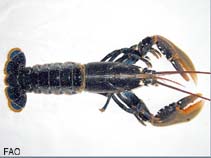Advertisement
Homarus gammarus (Linnaeus, 1758)
European lobster| Native range | All suitable habitat | Point map | Year 2050 |

|
| This map was computer-generated and has not yet been reviewed. |
| Homarus gammarus AquaMaps Data sources: GBIF OBIS |
France country information
Common names:
[No common name]
Occurrence: native
Salinity: marine
Abundance: | Ref:
Importance: highly commercial | Ref:
Aquaculture: never/rarely | Ref:
Regulations: restricted | Ref:
Uses: no uses
Comments: Legal Tlmin of capture of 23 cm (Lc=8.0 cm) deemed too small by the ACFM in 1978 and has since been increased (Ref. 80921). M: Ref. 74504.
National Checklist:
Country Information: https://www.cia.gov/library/publications/resources/the-world-factbook/geos/fr.html
National Fisheries Authority:
Occurrences: Occurrences Point map
Main Ref: Holthuis, L.B., 1991
National Database:
Occurrence: native
Salinity: marine
Abundance: | Ref:
Importance: highly commercial | Ref:
Aquaculture: never/rarely | Ref:
Regulations: restricted | Ref:
Uses: no uses
Comments: Legal Tlmin of capture of 23 cm (Lc=8.0 cm) deemed too small by the ACFM in 1978 and has since been increased (Ref. 80921). M: Ref. 74504.
National Checklist:
Country Information: https://www.cia.gov/library/publications/resources/the-world-factbook/geos/fr.html
National Fisheries Authority:
Occurrences: Occurrences Point map
Main Ref: Holthuis, L.B., 1991
National Database:
Common names from other countries
Classification / Names Populärnamn | synonymer | Catalog of Fishes (gen., sp.) | ITIS | CoL | WoRMS
Environment: milieu / climate zone / depth range / distribution range Ekologi
; djupintervall 0 - 150 m (Ref. 4), usually ? - 50 m (Ref. 4). Subtropical, preferred 12°C (Ref. 107945); 69°N - 29°N, 28°W - 32°E (Ref. 4)
Distribution Länder | FAO områden | Ekosystem | Förekomster | Utplanteringar
Eastern Atlantic, Mediterranean and Black Sea. Not in east of Crete and in the Baltic Sea.
Length at first maturity / Size / Weight / Age
Maturity: Lm 8.9, range 8 - 8.3 cm Max length : 65.0 cm TL hane/ej könsbestämd; (Ref. 441); common length : 40.0 cm TL hane/ej könsbestämd; (Ref. 441); publicerad maxvikt: 6.0 kg (Ref. 4); rapporterad maxålder: 72 år (Ref. 81081)
Common total length: 23 to 50 cm. Occurs on the continental shelf at depths of 0 to 150 m, usually not deeper than 50 m. Found on hard substrates such as rock or hard mud. Nocturnal and territorial living in holes or crevices. Females with eggs are usually found throughout the year. The eggs are laid around July and carried for 10 to 11 months (Ref. 4). Indiscriminate scavengers, omnivorous or carnivorous. Feeds primarily on malacostracan crustaceans, gastropod mollusks, and polychaete annelids; but diet known to include carrion, echinoderms, lamellibranchs and plant matter (Ref. 96319).
Life cycle and mating behavior Könsmognad | Reproduktion | Lek | Eggs | Fecundity | Larvae
Females with eggs are usually found throughout the year. The eggs are laid around July and carried for 10 to 11 months (Ref. 4). Coupling occurs a few days after the female molts (Ref. 80921).
Main reference
referenser | Koordinator | Medarbetare
Holthuis, L.B. 1991. (Ref. 4)
IUCN Red List Status
(Ref. 130435: Version 2024-2)
Least Concern (LC) ; Date assessed: 05 December 2009
CITES status (Ref. 108899)
Not Evaluated
CMS (Ref. 116361)
Not Evaluated
Human uses
Fiskeri: kommersiellt viktig; Vattenbruk: experimentell
FAO - fiskeri: landings, species profile | FishSource | Sea Around Us
Verktyg
Ytterligare information
Internet-källor
BHL | BOLD Systems | CISTI | DiscoverLife | FAO(fiskeri: species profile; publication : search) | GenBank (genome, nucleotide) | GloBI | Gomexsi | Google Books | Google Scholar | Google | PubMed | Tree of Life | Wikipedia (Go, sök) | Zoological Record
Estimates based on models
Preferred temperature
(Ref. 115969): 7.7 - 13.3, mean 10.4 (based on 494 cells).
Resiliens
(Ref. 69278)
Hög, lägsta populationsfördubblingstid mindre än 15 månader (K=0.79-1.0; Fec=13,000).
Prior r = 0.37, 95% CL = 0.25 - 0.56, Based on 1 data-limited stock assessment.




